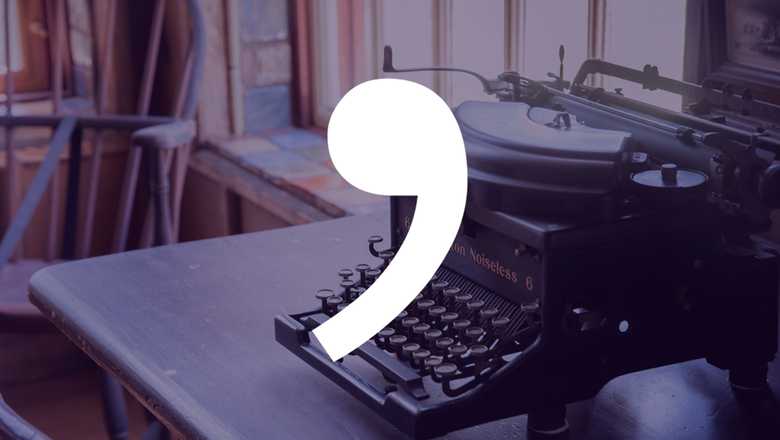Commas. They look so insignificant and innocent, but in reality they’re tricky little monsters that can have a big impact on a piece of writing.
As a professional editor, sorting out commas is one of my main tasks. No matter how good the writing, there are always comma issues that need correcting.
But wait, don’t you just put a comma where you need to pause in a sentence? Hell to the no. That’s not how commas work at all. Saying that you put a comma in a sentence whenever you want to create a pause is an oversimplified attempt to summarise several more complicated comma rules. It’s true that a comma does create a pause in a sentence, but reverse-engineering this idea doesn’t help you use commas correctly.
As well as creating pauses in a sentence, commas are used to separate sentence elements.
Visually separating ideas, items, actions and phrases with commas makes sentences easier to understand.
In a nutshell, the two main uses of the humble comma are:
- to create rhythm (by indicating a pause)
- to clarify meaning (by separating elements)
You may have an intuitive understanding of comma usage based on these two ideas. And the more you read, the better your understanding will be because you’ll have seen comma rules in action. You may have also been taught how to use commas at school or may have looked up a few guidelines yourself when you’ve felt unsure about your comma placement.
But yes, there are rules when it comes to using commas. Quite a few of them, unfortunately. However, as all good writers and editors know, rules are made to be broken!
That’s no excuse to throw commas around like confetti or avoid them altogether, though. (Oh, the horror.) Grammar and punctuation rules should only be broken when you know why you’re breaking them – in other words, when you’re aware of the effect you’re creating by doing so.
Which means you need to know what the rules are before you break them.
I know. Learning comma placement rules? Fun times.
It’s because of rule-breakery-creativity (that’s a technical term) that comma usage can be highly subjective. So let’s look at five comma placement rules and how they can be broken (without making your editor’s eye twitch*).
*Not guaranteed.
1. The serial comma
Okay, so this one isn’t strictly a rule, but it’s worth mentioning. The serial comma (also known as the Oxford comma or listing comma) is the final comma before ‘and’ in a list of three or more items, e.g. Sophie ate a pie, two cookies, and a square of chocolate.
Whether you want to use a serial comma is completely up to you. It’s a stylistic choice – not a rule you need to follow. In general, you should try to be consistent with your usage.
However, clarity trumps consistency, so you may decide to ‘break’ the rule you’ve imposed if the sentence needs it. And both the omission or inclusion of a serial comma can create confusion! For example:
- We partied with the burlesque dancers, Rick Grimes and Daryl Dixon.
Even though that sounds like a lot of flamboyant fun to me, the serial comma would remove the implication that Rick and Daryl are burlesque dancers. - We partied with the burlesque dancer, Rick Grimes, and Daryl Dixon.
The serial comma here could be mistaken for the second comma in a pair of commas offsetting the name of the burlesque dancer … which means Rick here could be the burlesque dancer.
Lesson: Decide whether you prefer to use the serial comma or not, then make your usage consistent – but allow exceptions to the ‘rule’ for clarity.
2. A comma should be used to separate compound sentences
The rule is that you should use a comma to separate two sentences joined by a coordinating conjunction (for, and, nor, but, or, yet, so – remember these by the fact the first letter of each spells FANBOYS). Here are some examples:
- Sophie wanted cake, but she also wanted cookies.
- Sophie didn’t want to leave the party, nor did she want Rick to change out of his fabulous burlesque costume.
- Everyone at the party was having fun, and even Daryl didn’t want to leave.
However, omitting these commas doesn’t often create much confusion. In shorter sentence (like the first example in the list above), it’s considered totally fine to omit the comma. How short should a sentence be before you omit the comma? There are no standard guidelines. Some people like to give themselves a rule, such as if the sentence is fewer than a certain number of words.
I recommend you use the comma in longer sentences (like in the last two in the list above), but if you want to create a faster-paced or more breathless sentence, you might decide to omit the comma.
Lesson: Use a comma between two sentences joined by a coordinating conjunction, but don’t sweat it too much if the sentence is short or if you want to play with the rhythm of your sentence, as long as you don’t sacrifice clarity.
3. Use commas to offset non-restrictive phrases
A non-restrictive phrase is simply a part of a sentence that adds extra meaning but when removed, the sentence still makes sense. It’s easier to explain with examples:
- Lena, who was intolerant to gluten, didn’t eat any cookies.
- Throwing a party, though lots of fun, is very tiring.
- James, who doesn’t drink alcohol, brought some lemonade to the party, and, after introducing himself to the host, he poured himself a glass.
That last sentence contains five commas, all of which are correctly placed; there are two pairs of commas offsetting non-restrictive phrases (‘who doesn’t drink alcohol’ and ‘after introducing himself to the host’) and one comma before a coordinating conjunction that links two sentences (‘James brought some lemonade, and he poured himself a glass’).
But it feels like a bit of comma overkill, right? The rhythm of the sentence becomes quite staccato because of all the commas, so I would recommend removing some to create a better flow. However, commas should only be removed if by doing so doesn’t make the sentence difficult to understand.
In my opinion, I think the following sentence is clear enough in meaning and reduction of commas creates a better flow:
- James, who doesn’t drink alcohol, brought some lemonade to the party, and after introducing himself to the host he poured himself a glass.
Lesson: More often than not you should offset non-restrictive phrases with commas, but if your sentence feels too choppy, delete commas that don’t make the sentence confusing to read. Remember, commas offsetting non-restrictive phrases in the middle of sentence must come in pairs, so you can’t delete one comma and keep the other – it’s both or none.
4. Use a comma after an introductory word, phrase or subordinate clause
A subordinate clause (also known as a dependent clause) is a part of a sentence that doesn’t make sense standing on its own. When a word, phrase or subordinate clause is used at the beginning of a sentence, you need a comma to offset it from the main (independent) clause.
- After the party, everyone went home to bed.
- As I climbed into bed, I started to feel very sleepy.
- Suddenly, I remembered I’d left the stove on.
Can you omit these commas? Again, it comes down to clarity and rhythm. It’s more acceptable to drop the comma after a single introductory word than it is for a whole introductory phrase or clause.
There is an exception to this flexibility, though, and that’s when the introduction is a participle phrase describing the subject of the sentence. A participle phrase is a phrase that tells us something about the noun it’s modifying that starts with a participle (a word formed from a verb that can be used as an adjective). Yeah, it’s pretty difficult to explain – examples help!
- Searching the kitchen cupboards, Sophie looked for hidden chocolate.
- Frightened by a car backfiring, the cat ran under the couch.
- Wondering where the cat had gone, Sophie gave up looking for chocolate.
Omitting these commas can create confusion and is considered grammatically incorrect, so this is a rule that shouldn’t usually be broken.
Lesson: It’s normally okay to omit a comma that separates an introductory phrase or subordinate clause if the meaning is still clear; it’s even more acceptable to drop the comma after a single introductory word. However, you shouldn’t omit the comma before an introductory participle phrase, otherwise the grammar police will come knocking.
5. Use commas to offset ‘yes’ and ‘no’, direct address, interjections and questions
You might think you can’t argue with this comma usage, but … I’m here to tell you that you can – at least for some of these structures. Usually, I’m all for this type of comma. And for the most part, it makes sense to follow this rule.
- Yes, I do enjoy chocolate cake.
- No, I won’t eat it all.
- Oh, I didn’t realise it was your birthday.
- George, would you like a slice of cake?
- He’ll save some for me, won’t he?
- Anyway, Sophie, I thought you were on a diet?
You might decide to omit the comma offsetting ‘yes’ or ‘no’ to create the effect of a lack of pause. Perhaps a character is snapping something at another. (‘No of course I didn’t eat all the cake!’) Or perhaps an accumulation of these commas creates clutter and negatively affects the rhythm. For example:
- Oh, yes, George, why I would like a slice of cake.
- Oh yes, George, why I would like a slice of cake.
The second sentence reads better, don’t you think?
I wouldn’t advise omitting commas when they’re used to offset a question or an interjection in the middle of a sentence – the sentences will probably lack clarity (and possibly sense) without them.
Lesson: Omit these commas only when an accumulation of them looks clunky and if the clarity or sense of your sentence isn’t affected.
And there you have it. Five comma rules you can break, if you know how and why you’re breaking them.
(You rebel, you.)
Massive hat tip to Arlene Prunkl’s post, ‘Commas demystified! The top 10 uses for commas—made simple’, which is my go-to resource when I’m feeling confused about the rules of comma usage. (That’s right, commas can confuse editors, too!)
Remember: commas are our friends. They might be frustrating little monsters most of the time, but without them our writing would lack meaning and rhythm. Keep this at the forefront of your mind, and use it to guide your decisions on where to place or omit them.





